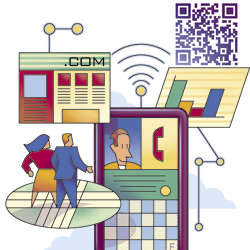EMPTY-BOOTH BAND-AIDS
 When show attendance wanes, my booth seems
embarrassingly empty of attendees and jammed to the hilt with staffers. What can I do to
alleviate this problem and make my booth look more inviting? When show attendance wanes, my booth seems
embarrassingly empty of attendees and jammed to the hilt with staffers. What can I do to
alleviate this problem and make my booth look more inviting?
 Attendance at almost all industry trade shows was down considerably in 2009, and 2010 has seen marked decreases as well. But even when shows are teeming with attendees, many events experience a big drop in attendance on the last day. No matter the cause, when attendance drops, many exhibits seem to empty of attendees and fill up with staffers - creating a psychological barrier for attendees. That's because people are generally drawn to booths that have attracted a crowd, as they want to see for themselves what has captured the attention of their peers - and to get their own piece of the action. Attendance at almost all industry trade shows was down considerably in 2009, and 2010 has seen marked decreases as well. But even when shows are teeming with attendees, many events experience a big drop in attendance on the last day. No matter the cause, when attendance drops, many exhibits seem to empty of attendees and fill up with staffers - creating a psychological barrier for attendees. That's because people are generally drawn to booths that have attracted a crowd, as they want to see for themselves what has captured the attention of their peers - and to get their own piece of the action.
In the same vein, attendees are often repelled by empty booths, often
thinking something like, "Well if nobody else is buying this product, why should I?" Similarly, attendees are often scared off by too many staffers, who, they assume, are ready to pounce on them should they show even a hint of interest in the exhibitor's product.
So while you certainly want to match your booth and staff size to the show's expected attendance figures, there are some steps you can take to make your booth seem less empty - and not overrun with salivating salespeople. Here are three ways to change the way attendees perceive your space without drastically reducing your footprint or staff count.
1. Be strategic about staff apparel.
If your booth is swimming with staffers, dress roughly half of your team in traditional logoed attire and instruct the remaining half to wear clothes typically worn by your target audience. For example, at the International Consumer Electronics Show, half of your staff would wear logoed shirts and the other half would wear dress pants and a nice shirt. But at the World of Concrete, half the staff might wear logoed attire while the other half wears jeans, casual shoes, and polo shirts.
That way, when attendees look into your exhibit, they'll see a mix of staff in official gear and a bunch of other people dressed just like they are. While your entire booth may be filled with staff rather than attendees, most people will assume that half of the people are staff and half are attendees.
At one show a few years ago, for example, Siebel Systems Inc. (which has since been acquired by Oracle Corp.) took this strategy one step
further. Its entire exhibit staff wore suits.
Not only did staffers appear professional, but even when traffic was light,
the booth always appeared to be rocking with savvy, smart-looking businesspeople who fit right in with the attendees at that event.
If, however, company management wants all staff in logoed attire, you can still try to mix it up. Rather than creating a sea of same-colored shirts, dress your staff in different colors of the same logoed shirt. For example, dress some people in red, others in blue, and the remainder in orange. Doing so will help make you staff seem more like attendees and less like an occupying army.
2. Unclog your arteries.
If you've read anything by retail-design guru Paco Underhill, you know people like space to maneuver. In fact, his extensive studies have identified what he calls the "butt-brush" factor. He has concluded that most people - and women in particular - are uncomfortable in narrow aisles, especially when there's not enough room for someone to pass behind them without brushing their derrière in the process.
The bottom line, so to speak, is that we don't like being jammed up next to each other when we're shopping - or perusing a booth for that matter. While this has nothing to do with an empty booth, the butt-brush factor comes into play when your booth appears jammed with staff who all congregate near a specific product display.
While you don't want your booth to be empty, people also need some personal space to maneuver within it. So always monitor the location of staffers within your space. Urge them to stand near but not within tight product-display areas, and to try not to clog up any in-booth traffic paths attendees use to traverse your exhibit. Rather, position booth staffers where they can quickly and easily greet visitors and answer questions, but where they'll also seamlessly blend into the environment rather than clogging up its main arteries.
Plus, make sure you have the appropriate number of staff not only for your booth size, but for each particular show. Analyze the number of leads you typically obtain at each show, the number of staff you've used in the past, as well as the show's anticipated attendance figures. Then plan accordingly based on not only your past results but also current attendance predictions. As a general rule of thumb, Skip Cox at Exhibit Surveys Inc. indicates that exhibitors need one staffer for every 50 square feet of open exhibit space, i.e., space not occupied by exhibitry.
3. Downsize presentation areas.
We've all seen them: the 50-seat in-booth theater with Cirque performers dangling from truss, confetti cannons showering the crowd, and enough booming music and theatrical lighting
effects to make it seem like the Fourth of July. When these theaters are packed, they're poetry in motion, as staffers cycle through sessions and scan endless attendees' badges like they're working on an assembly line. But when attendance drops, those 50-seat theaters can easily become embarrassing ghost towns teeming with nothing but obviously empty chairs and leftover confetti.
So unless you're positive that every one of your presentations will fill your seating, trade your 50-seat theater for something smaller. Even 15 people sitting in a theater set for 40 looks like a failure. But put those same 15 people in a 10-seat theater, and your booth looks like a mob scene - which, in itself, will likely draw even more people into your booth.
In addition, you'll get more show-floor buzz as passersby talk with their peers. "Have you seen what XYZ is doing? Man, their theater has been jammed all day," they might say. Nobody's ever going to say "Yeah, but there were only 15 people in it." People won't notice the number of participants; they'll only notice how full or empty the theater appeared to be.
Even if you think your presentation
can draw hundreds of attendees per
day, keep the theater small, and then
shorten the presentations and increase their frequency throughout the day. Rather than offering four 30-minute presentations per day, for example, break that content into three chunks, and offer each chunk three times per day. So instead of comprising four presentations, the same content is now spread out over 12 presentations.
If you publish a schedule including
your times and topics, you might even score repeat visitors who are
interested in different topics. That way, your theater remains small, the likelihood of it filling up is greater, and yet attendees still have access to the same information throughout the show.
So if you often find your booth void of attendees and overflowing with staffers, try one of these three "perception-bending" tactics. After all, the reality of who's in your booth and what's actually happening isn't nearly as important as what attendees perceive is happening and who they think is filling your space.
- John Tatusko, space and sponsorship strategist, Nth Degree Inc., Duluth, GA
|







 Attendance at almost all industry trade shows was down considerably in 2009, and 2010 has seen marked decreases as well. But even when shows are teeming with attendees, many events experience a big drop in attendance on the last day. No matter the cause, when attendance drops, many exhibits seem to empty of attendees and fill up with staffers - creating a psychological barrier for attendees. That's because people are generally drawn to booths that have attracted a crowd, as they want to see for themselves what has captured the attention of their peers - and to get their own piece of the action.
Attendance at almost all industry trade shows was down considerably in 2009, and 2010 has seen marked decreases as well. But even when shows are teeming with attendees, many events experience a big drop in attendance on the last day. No matter the cause, when attendance drops, many exhibits seem to empty of attendees and fill up with staffers - creating a psychological barrier for attendees. That's because people are generally drawn to booths that have attracted a crowd, as they want to see for themselves what has captured the attention of their peers - and to get their own piece of the action. 


